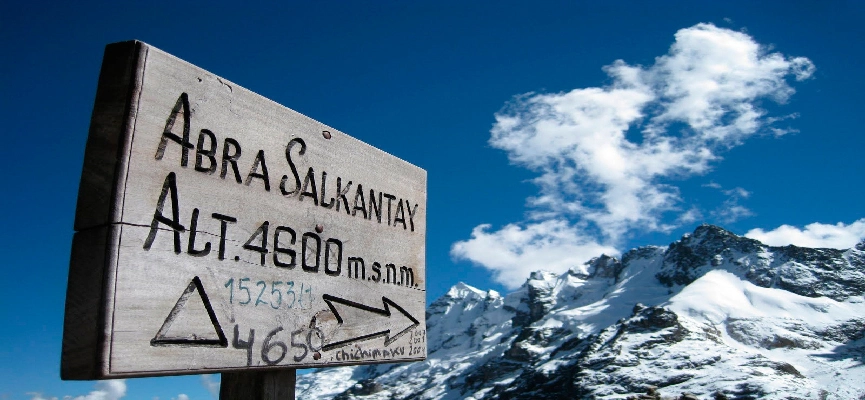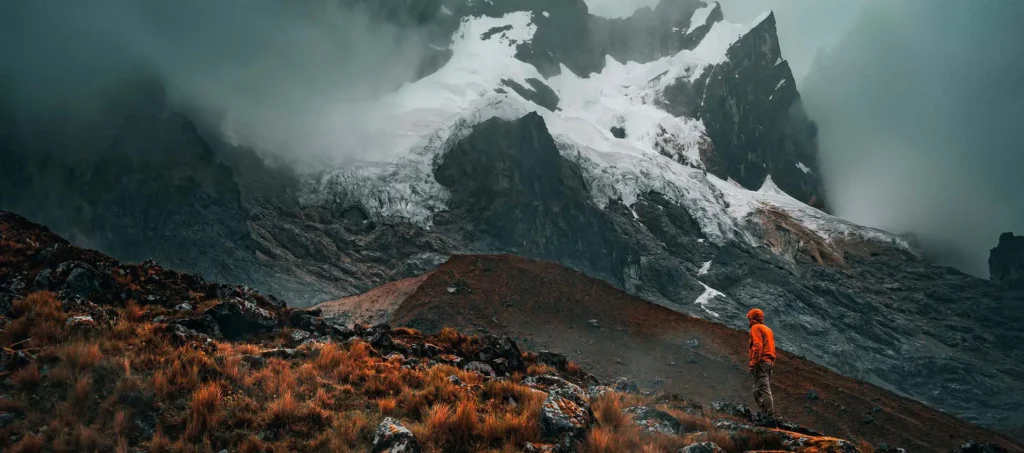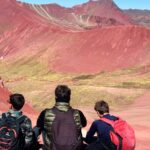Salkantay Trek 3 days

A visit to Peru without stopping at Machu Picchu could feel incomplete, but I was looking to get there in a unique and more impactful way. That is why I was looking for alternatives to the usual train visit or the Inca Trail. I wanted to go off the beaten path and make a local impact. I learned about Orange Cares and immediately became engaged with their approach towards tourism.
Researching about the Salkantay Trek I was so excited about visiting unique and privileged landscapes on my way. So here I want to share my experience on the 3-day Salkantay Trek.
Day 1: Conquering the Altitude
We left Cusco before sunrise following one of the most scenic rides. As the first rays of sunlight appeared the anticipation built up. The road took us up to the trailhead and I could feel my heart pounding, both for the altitude and the excitement.
About 4 hours after leaving Cusco, we arrived in Soraypampa. On our way we enjoyed a tasty breakfast at Mollepata. Once at the trailhead we geared up, adjusted our backpacks and set off on the adventure. The first 10 minutes felt eternal. I was extremely short of breath and my heart was racing, but the guide was very helpful showing me breathing techniques and sharing some coca leaves.
As we climbed up the trail the landscape started to change, welcoming us into the solitude of the Andean Peaks. Rocky and loose trails with glaciers and massive mountains in the background set the perfect scene. There was one particular element in the landscape that captured my attention, Apu Salkantay. This massive snow-capped mountain in the local tradition is considered a deity or an Apu and only by being here I understood why.
Salkantay Pass
The highest point of the day and the trek was the Salkantay Pass at 4650 m. Reaching this spot was unreal, the panoramic views in combination with the energy of this place made this spot my absolute highlight of the day. I pushed my physical limits and I can tell you it was absolutely worth all the effort.

Following this break, we took on the descending portion of the day. First to Huayracmachay to enjoy a tasty lunch and then to Collpapampa to find our campsite. Along this segment we experienced how the trail took us to a very different ecosystem, the cloud forest. Having the chance to actually traverse over the Andes into the jungle is unreal. We left the van in the morning at the Puna to arrive at the lush lower forests at Chaullay. This authentic journey finds its perfect closure camping under the stars.
Day 2: A journey through history
Waking up in the middle of nature, is a relaxing experience. The gentle hum of the forest invited us to start a new day of this experience. We enjoyed the breakfast, to later pick up our backpacks and start the challenges of the day.
The adventures of the second day started with a car ride to Lucmabamba, from there we started the hike of the day. The ride wound downward, and the air warmed. Trees grew taller and greener. Life during the following days was more vibrant and abundant, which added excitement to every single step.
Once in Lucmabamba we started hiking upwards, the goal was the archeological site of Llaqtapata. It took us about 3 hours, but the trail is so beautiful you forget how far you have to hike. The slopes of the mountain are filled with vegetation, the colorful orchids stand out.
Llaqtapata
Reaching Llaqtapata felt like the first real connection to Machu Picchu. After a steady climb, the forest suddenly opened and the small terraces appeared on the ridge. From there, I saw Machu Picchu for the first time on this trek, distant but unmistakable across the valley.
I took a few minutes to walk around the site and understand its purpose. Our guide explained that Llaqtapata was likely a strategic lookout and a place the Incas used to monitor access to the region. Standing there, the location made perfect sense. It offered a clear line of sight to the main routes and to the city itself. From Llaqtapata on, the anticipation of reaching Machu Picchu only grew stronger.

After this stop we descended to Hidroelectrica for lunch, followed by the last 3 hours hiking to Aguas Calientes. This last stretch of the day follows the Urubamba Canyon and the trainlines to Aguas Calientes. Hiking along this final segment offers the opportunity to enjoy the jungle, alternative views of the Inca Citadel and the stunning nature around the area.
The second night was spent at a hotel room in Aguas Calientes, which was very welcome.
Day 3: Machu Picchu at Dawn
Mixed emotions came with the last day of this adventure. I was relieved by not having to walk extensively this day, but also excited about finally visiting Machu Picchu. After all I’ve spent the past 2 days pushing my limits and letting nature amaze me, with the goal of arriving transformed to my final stop.
Once at the citadel, our guide walked us through the main areas, explaining what researchers have learned over the years. Walking into Machu Picchu felt like stepping into a dream. The mist curled around the stone walls, terraces, and temples. For a moment, I wasn’t sure what was real.
Highlights:
- Sacred Plaza: An open space for ceremonies. The Temple of the Three Windows stood out for its role in tracking the Sun and marking seasonal changes, essential for agriculture. It also reflects the Inca concept of the three worlds: Hanan Pacha, Kay Pacha, and Uku Pacha.
- Casa del Inca: The presumed royal residence. The layout, construction quality, and central boulder suggest its importance. The small carved fountains in the rock may have served as reflective surfaces to observe the sky.
- Temple of the Sun: Impressive not only for its design but for its precise alignment with astronomical events, another example of the long Andean tradition of sky observation.
- Quarry Area: Helped visualize the labor behind building Machu Picchu. Despite the mountain being mostly rock, shaping and transporting blocks required skill and planning.
- Terraces: Surround the site and reveal advanced agricultural engineering. Their drainage systems and soil preparation show how the Incas optimized farming in steep terrain.



Why I would recommend this Trek
- Diverse Landscapes: In just three days, you go from snow-capped mountains to lush tropical forest. It’s like walking through the spine of the Andes.
- Spiritual Connection: Salkantay trek is a pilgrimage. The pass, the peaks, the valleys, the ruins, each feels alive.
- Less Crowded: Compared to the classic Inca Trail, Salkantay feels more raw, more intimate.
- Rewarding Arrival: You reach Machu Picchu having earned it. The journey gives extra meaning to that moment.
- Solid Support: Logistics, camping, food and guidance are handled professionally, so you can focus on being present in the moment.
Tips from My Experience
- Acclimate First: Spend at least 1–2 days in Cusco to adjust to the altitude.
- Pack Smart: Layers, good trekking boots, a durable raincoat and a warm sleeping bag are musts.
- Stay Hydrated: Bring a reusable water bottle, dehydration at high altitude happens faster.
- Mindset Matters: The trek is challenging. Pace yourself. Trust your guides. Let yourself feel whatever arises.
- Be Respectful: These are sacred landscapes. Move thoughtfully, leave no trace and listen deeply.
- Reserve Early: The 3-day Salkantay is very popular, especially in high season.
Final Thoughts
If you’re looking for a trek that’s adventurous but soulful, raw but supported, challenging but absolutely worth it, then the 3-day Salkantay Trek is calling you. Do it. And bring your heart and mind ready to be transformed by this experience.

